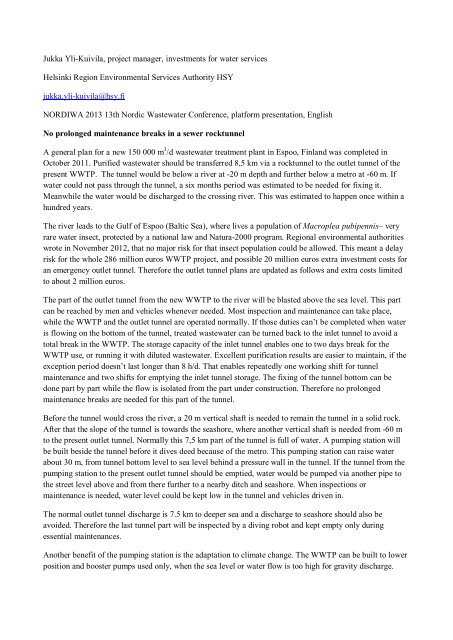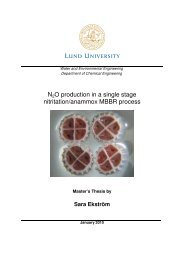Kemira Oyj/Kemira M&I ABSTRACT Vesa Kettunen ... - Svenskt Vatten
Kemira Oyj/Kemira M&I ABSTRACT Vesa Kettunen ... - Svenskt Vatten
Kemira Oyj/Kemira M&I ABSTRACT Vesa Kettunen ... - Svenskt Vatten
You also want an ePaper? Increase the reach of your titles
YUMPU automatically turns print PDFs into web optimized ePapers that Google loves.
Jukka Yli-Kuivila, project manager, investments for water services<br />
Helsinki Region Environmental Services Authority HSY<br />
jukka.yli-kuivila@hsy.fi<br />
NORDIWA 2013 13th Nordic Wastewater Conference, platform presentation, English<br />
No prolonged maintenance breaks in a sewer rocktunnel<br />
A general plan for a new 150 000 m 3 /d wastewater treatment plant in Espoo, Finland was completed in<br />
October 2011. Purified wastewater should be transferred 8,5 km via a rocktunnel to the outlet tunnel of the<br />
present WWTP. The tunnel would be below a river at -20 m depth and further below a metro at -60 m. If<br />
water could not pass through the tunnel, a six months period was estimated to be needed for fixing it.<br />
Meanwhile the water would be discharged to the crossing river. This was estimated to happen once within a<br />
hundred years.<br />
The river leads to the Gulf of Espoo (Baltic Sea), where lives a population of Macroplea pubipennis– very<br />
rare water insect, protected by a national law and Natura-2000 program. Regional environmental authorities<br />
wrote in November 2012, that no major risk for that insect population could be allowed. This meant a delay<br />
risk for the whole 286 million euros WWTP project, and possible 20 million euros extra investment costs for<br />
an emergency outlet tunnel. Therefore the outlet tunnel plans are updated as follows and extra costs limited<br />
to about 2 million euros.<br />
The part of the outlet tunnel from the new WWTP to the river will be blasted above the sea level. This part<br />
can be reached by men and vehicles whenever needed. Most inspection and maintenance can take place,<br />
while the WWTP and the outlet tunnel are operated normally. If those duties can’t be completed when water<br />
is flowing on the bottom of the tunnel, treated wastewater can be turned back to the inlet tunnel to avoid a<br />
total break in the WWTP. The storage capacity of the inlet tunnel enables one to two days break for the<br />
WWTP use, or running it with diluted wastewater. Excellent purification results are easier to maintain, if the<br />
exception period doesn’t last longer than 8 h/d. That enables repeatedly one working shift for tunnel<br />
maintenance and two shifts for emptying the inlet tunnel storage. The fixing of the tunnel bottom can be<br />
done part by part while the flow is isolated from the part under construction. Therefore no prolonged<br />
maintenance breaks are needed for this part of the tunnel.<br />
Before the tunnel would cross the river, a 20 m vertical shaft is needed to remain the tunnel in a solid rock.<br />
After that the slope of the tunnel is towards the seashore, where another vertical shaft is needed from -60 m<br />
to the present outlet tunnel. Normally this 7,5 km part of the tunnel is full of water. A pumping station will<br />
be built beside the tunnel before it dives deed because of the metro. This pumping station can raise water<br />
about 30 m, from tunnel bottom level to sea level behind a pressure wall in the tunnel. If the tunnel from the<br />
pumping station to the present outlet tunnel should be emptied, water would be pumped via another pipe to<br />
the street level above and from there further to a nearby ditch and seashore. When inspections or<br />
maintenance is needed, water level could be kept low in the tunnel and vehicles driven in.<br />
The normal outlet tunnel discharge is 7.5 km to deeper sea and a discharge to seashore should also be<br />
avoided. Therefore the last tunnel part will be inspected by a diving robot and kept empty only during<br />
essential maintenances.<br />
Another benefit of the pumping station is the adaptation to climate change. The WWTP can be built to lower<br />
position and booster pumps used only, when the sea level or water flow is too high for gravity discharge.
















